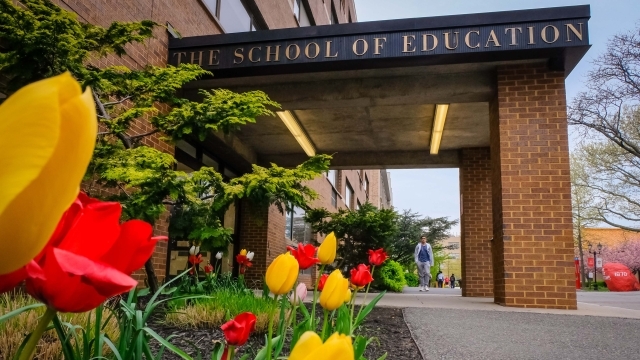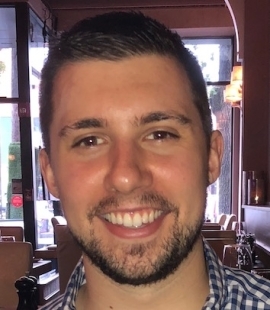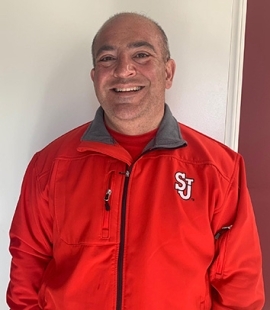
When elementary school and high school buildings across New York State were closed due to COVID-19 in early March, teachers, students, and parents all had to adjust to an entirely new style of learning for the duration of the school year. For some, the change was easy; for others, it has been a struggle.
St. John’s discussed this unprecedented transition with two alumni from The School of Education (SOE): Thomas Canale ’13Ed and Christian Soto ’00Ed, ’02GEd, ’11Ed.D.

Mr. Canale teaches 10th-grade English at East Rockaway High School in Nassau County. While he originally had his sights set on a career in law, he had a change of heart after learning about SOE from students and faculty at a St. John’s open house. During his four years at the University, Mr. Canale was a Dean's Scholar, the highest academic honor in SOE; a member of Kappa Delta Pi, the international honor society in education; and President of the local chapter of Active Minds, a mental health advocacy group.

A triple alumnus of St. John’s, Dr. Soto teaches sixth-grade English Language Arts and Social Studies at Centre Avenue School, also in the East Rockaway district. A scholar-athlete, Dr. Soto was a kicker and punter for the now defunct Red Storm football team as an undergraduate. While pursuing his master’s degree, he worked as a graduate assistant in the Office of Conference Services and returned to St. John’s years later to earn his Ed.D.
While both teachers began remote teaching activities in the district in mid-March, their experiences differ, due in part, to the ages of their students.
Can you explain the process of altering an existing syllabus to fit a remote learning environment?
Thomas Canale (TC): My essential questions and learning intentions are the same, but the way that I envision students actively participating in the lesson has to be reimagined. Thankfully, technology has been central in providing students the opportunities to fully engage in the lessons.
Christian Soto (CS): Remote learning can never replace a traditional school setting. A teacher must be flexible and adjust to the “new norm.” Creating a syllabus that still has the same learning intentions and outcomes is essential, but the way we deliver instruction needs to be altered to fit the realm of technology and the virtual world.
Have you found that one type of instruction -- live, asynchronous, or a combination of both –has been more successful than another?
TC: In my classes, live instruction has generally been more successful than asynchronous, because it allows me to learn from my students and get their feedback. Live lessons allow me to check for understanding in real-time, and if something isn’t working for my students, I can adapt instantly to meet their needs.
CS: Each child has a different learning style. Some students prefer synchronous learning because they thrive on classroom engagement, while others flourish with asynchronous learning’s flexibility and pacing.
Was any part of this adjustment particularly challenging to you?
TC: The most challenging part is not being able to see my students in person, since there is only so much that can be communicated from behind a screen. Seeing a student in the hallway and asking, “How are you?” can reveal so much more than asking that same question during a videoconference.
CS: The biggest challenge has been the use of technology and the occasional distractions of working from home.
How did your St. John’s education prepare you for teaching under the current circumstances?
TC: I was a good student, and I generally expected to earn an A on all of my papers. However, in my Shakespeare and Politics course, I did not receive an A. It sent a shockwave through my system. I asked for help at the University Writing Center. The experience taught me that when life does not go as expected, it is important to find help.
Now, I seek guidance from my chairperson and my colleagues. Of course, my writing process does not compare to the current pandemic, but it reminds me that these are difficult circumstances, and we have to face our challenges head-on.
CS: St. John’s exposed me to different teaching strategies that can be implemented in various situations. I learned the importance of social-emotional learning and focusing on a child’s well-being. Those skills have certainly helped me through the pandemic.
What are some of the challenges your students are experiencing, and how have you responded?
TC: A number of students struggle with not having a regimented routine. As much as we may scoff at the “everyday shuffle,” I remind students that a self-imposed routine is essential to providing a sense of normalcy and stability from which we can all benefit.
CS: Since my students are 11 and 12 years old, they can certainly have challenges with time management and setting routines. Technology can be a problem, too. There are some students who have feelings of isolation and may be experiencing family or personal health issues. I make a special effort to stay connected to them—including platforms such as Google Meet, school video messages to students, and personal phone calls to students and parents.
What “outside of the box” solutions have you created to keep students engaged?
TC: I use different technology platforms, such as Nearpod and Edpuzzle; they can work at their own pace and revisit materials as they see fit.
CS: I try to come up with creative and innovative activities to engage all of the students in the grade, including video lessons, time capsules, a talent show, multimedia projects, science experiments, and virtual class debates.
What advice do you have for students who may struggle with this style of learning?
TC: These are life skills that typically come over time—not during a pandemic. I would encourage them to not be hard on themselves. Making mistakes is an essential part of learning, so reframing this time as a period for growth is essential.
I recommend putting the phone and TV away. If possible, find a quiet place with minimal distractions to complete your work. Soft background music can provide the ambient white noise to elicit the peace and relaxation needed to focus.
CS: It is important to always be in contact with your teacher. Email them with any questions or concerns you may have. Be patient with technology and set up a schedule. Find a space that is quiet, so you have no interruptions. Finally, take “brain breaks” every so often. They work!
What advice do you have for parents of students?
TC: My advice is to practice self-care, which seems like an absolute impossibility during this time, but is so critical to everyone’s mental health. Establishing a routine and modeling positive behaviors can help create the structure and predictability that students need.
CS: Be patient with your child and his or her teachers. This is all new to everyone, and teachers are learning as they go along, too. Check in with your child’s teacher, and be visible when your child is completing assignments.
If there is a silver lining to the current reality, what would it be?
TC: The silver lining has to be time. In a way, time has slowed down, and I am able to reflect on my life with more gratitude. I know the sacrifices that so many individuals are making and the pain that so many have endured during this time. For me, the blinders have been taken off, and I appreciate all that I have.
CS: While I miss my students, I am blessed to have more time at home to watch, nurture, and see my own two children grow before my eyes. In addition, this situation gives us all the opportunity to learn more about other resources that can be used to enhance learning in the classroom when we return.
Related News
Alumna Celebrates Book Launch After Career Change
After developing a passion for helping the younger generation, Ashley Wilson ’14M.S.Ed. pivoted from a career in the music industry to work as an educator. She is also making her mark through her new...
Dean Jerrold Ross Conference Room Unveiled
On Tuesday, December 10, the newly renovated conference room on the fifth floor of Sullivan Hall was dedicated in honor of Jerrold Ross, Ph.D., former Dean of The School of Education . The renovation...
Institute for Catholic Schools Provides Educational Resources to Local Catholic School
The Institute for Catholic Schools (ICS) in The School of Education at St. John’s University recently donated approximately $2,800 worth of academic and sensory learning tools to Father Vincent...
